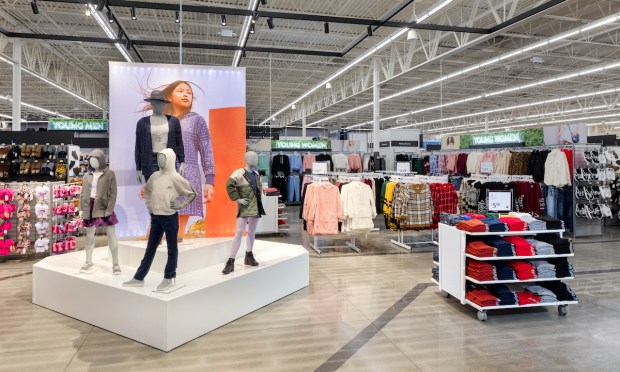Walmart Apparel EVP: We Can Make Luxury Fashion Affordable

Consumers are increasingly prioritizing convenience when making shopping decisions, leading to the rise of the “one-stop shop” concept. Retailers aspire to offer a comprehensive array of products and services, consolidating everything under a single roof. The real worth of a one-stop retailer, however, goes beyond convenience to deliver both competitive prices and quality.
This ethos aligns with the vision of Denise Incandela, executive vice president of apparel and private brands at Walmart, who is spearheading the expansion of the retail giant’s presence in the fashion category, offering a high-end aesthetic without high-end price tags.
In a conversation with PYMNTS, Incandela delved into Walmart’s mission, which extends beyond offering competitive price points and encompasses curating fashion pieces that cater to every facet of a customer’s wardrobe.
“Winning in basics alone doesn’t enable us to win in fashion. And we know that we have 140 million people coming into our stores and online every week and so being able to support more of her closet with a broader, expanded array … that’s what the focus has been,” said Incandela.
Walmart’s Formula for Democratizing Fashion
To achieve this goal, Walmart has developed a strategy comprising three essential components. The first component revolves around a substantial revamp of their product assortment. Within this aspect, Walmart has adopted a multifaceted approach.
Incandela said Walmart strives to introduce a diverse range of affordably priced products and has allocated significant resources to its design teams to enhance both the quality and style of these budget-friendly offerings.
As highlighted by Incandela, Walmart boasts a portfolio of 14 private brands, with six of them exceeding $1 billion in sales.
The second facet of the retailer’s strategy involves the development of elevated private brands, often referred to as exclusive brands. Walmart has strategically partnered with celebrities and style authorities such as Brandon Maxwell — who is Walmart’s creative director for Scoop and Free Assembly — Sofia Vergara, Michelle Smith and Stacy Griffith.
“Bringing in that kind of designer credibility and talent into the organization, so that we can offer products beyond the opening price points, expand average unit retails, and introduce a level of quality and style that we haven’t offered before, and is something exclusive to Walmart,” Incandela said.
The third and final element of Walmart’s strategy is incorporating well-established national brands into its product offerings. This approach involves bringing in popular national brands — such as Reebok, Justice, Chaps and USPA — that resonate with its customer base. This expansion of national brands addresses customer demand and represents a departure from Walmart’s previous, more limited offerings in this category.
What Apparel Democratization Looks Like Online
As Walmart contemplates the future of online shopping, Incandela said the retailer recognizes the growing role of artificial intelligence (AI) in shaping this journey. The primary aim is to deliver a more tailored and meaningful experience for customers.
Within this context, the potential applications of AI are manifold, including its utilization in product attribution. This entails the identification of intricate product details, ranging from clothing type to sleeve length and collar style. While Walmart collaborates with various marketplace partners, Incandela said not all product intricacies are consistently provided, but customers often seek this level of specificity in their searches. Here, AI assumes a central role by attributing those essential details to products.
Another promising avenue for AI is virtual try-on technology, which uses virtual models so customers can visualize how clothing items would look on them. Walmart places emphasis on personalization, ensuring that customers receive search results and browsing suggestions that align with their preferences. AI is instrumental in achieving this.
In addition, the concept of “Complete the Outfit” is integral to Walmart’s strategy.
“We’re all inherently insecure on how to put outfits together,” said Incandela, who believes this is where tools like mannequins come into play. By providing guidance on how a particular garment can be styled, it instills confidence in customers.
It also promotes cross-shopping, an important facet, as it simplifies the shopping experience, akin to having a personal shopper in the store.
How It Plays Out in-Store
“We’re on a journey right now,” said Incandela, describing the progress of Walmart’s store renovation efforts. “We really focused on creating an inspiring shopping experience where the product is the hero.”
To achieve this, she said, Walmart has opted to reduce the inventory on its racks by 10%. Additionally, Walmart has removed price tags from the front of its brand shops, which house premium national and exclusive brands. This allows the products to take center stage.
The goal is to provide customers with more than just affordable clothing: it’s about offering beautiful apparel, democratizing fashion while delivering value. This approach extends to the in-store environment, where Walmart has introduced mannequins to create an inspiring and uncluttered shopping atmosphere.
As of now, Walmart is in the process of renovating its stores, having embarked on more than 100 remodels within this year alone. The goal is to exceed 300 remodels by the year’s end. Walmart’s primary focus will be on elevating the fashion sections of its stores to enhancing the overall shopping experience for customers.
For all PYMNTS retail coverage, subscribe to the daily Retail Newsletter.

